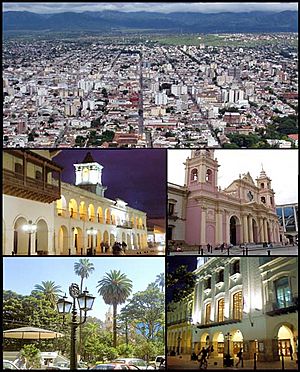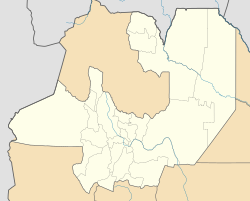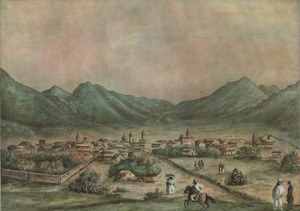Salta facts for kids
Quick facts for kids
Salta
|
||
|---|---|---|

Clockwise from top left: view of the city from top of San Bernardo Hill; Cathedral of Salta; Victoria Theatre; Ninth of July Plaza; and Colonial Cabildo
|
||
|
||
| Country | ||
| Province | Salta | |
| Department | Capital | |
| Founded | 1582 | |
| Area | ||
| • City | 120 km2 (50 sq mi) | |
| Elevation | 1,152 m (3,780 ft) | |
| Population
(2010 census)
|
||
| • Urban | 535,303 | |
| • Metro | 619,000 | |
| Demonym(s) | Salteño | |
| Time zone | UTC−3 (ART) | |
| CPA base |
A4400
|
|
| Dialing code | +54 387 | |
| Climate | Cwb | |
Salta (Spanish: [ˈsalta]) is a large city in Argentina. It is the capital of the Salta Province. With over 618,000 people, it is one of the biggest cities in Argentina. Salta is an important center for culture and business in its region. It is also the main city of the Capital Department.
Contents
History of Salta: A Look Back in Time
Salta was started on April 16, 1582. A Spanish explorer named Hernando de Lerma founded it. He wanted Salta to be a stop between Lima, Peru and Buenos Aires. The exact meaning of the name Salta is still a bit of a mystery.
During the War of Independence, Salta became a key spot for trade and military actions. It was located between Perú and other Argentine cities. From 1816 to 1821, a local military leader, General Martín Miguel de Güemes, protected the city. He worked under General José de San Martín to defend Salta from Spanish forces.
After the war, Salta faced many challenges. It was not organized and had money problems for a long time. But in the late 1800s and early 1900s, things got better. Many people from Italy, Spain, Britain, and Arab countries moved to Salta. They helped bring back trade and farming, making the city even more diverse.
Geography and Weather in Salta
Salta's Climate: Enjoyable All Year Round
Salta has a subtropical highland climate. This means it has pleasant weather throughout the year. The city is in the subtropical north but sits high up, about 1,200 meters (3,900 feet) above sea level. This gives Salta four clear seasons.
- Summers are warm with many thunderstorms. Daytime temperatures are around 26 to 28°C (79 to 82°F). Nights are cool and refreshing, about 15 or 16°C (59 or 61°F).
- Fall brings dry weather. Days are nice at about 22°C (72°F), and nights are mild at around 10°C (50°F).
- Winters are very dry with little rain. Nights are cool, averaging 3°C (37°F). But days warm up to about 19°C (66°F). Snow is rare, but frost is common. Temperatures can drop to -7°C (19°F) on the coldest nights.
- Spring is sunny with warm days and mild nights. Days range from 25 to 28°C (77 to 82°F), and nights are between 10 and 14°C (50 and 57°F).
Salta gets over 700 millimeters (28 inches) of rain each year. Most of this rain falls from December to March. During this time, thunderstorms happen almost every day. For the rest of the year, the skies are usually clear and blue. The summer storms make the mountains around the city green and lush. Salta gets about 5.1 hours of sunshine every day.
| Climate data for Salta, Argentina (Martín Miguel de Güemes International Airport) 1991–2020, extremes 1873–present | |||||||||||||
|---|---|---|---|---|---|---|---|---|---|---|---|---|---|
| Month | Jan | Feb | Mar | Apr | May | Jun | Jul | Aug | Sep | Oct | Nov | Dec | Year |
| Record high °C (°F) | 36.4 (97.5) |
35.1 (95.2) |
34.0 (93.2) |
34.3 (93.7) |
34.2 (93.6) |
34.6 (94.3) |
37.2 (99.0) |
37.8 (100.0) |
37.8 (100.0) |
39.3 (102.7) |
39.9 (103.8) |
39.6 (103.3) |
39.9 (103.8) |
| Mean daily maximum °C (°F) | 27.7 (81.9) |
26.5 (79.7) |
25.1 (77.2) |
22.9 (73.2) |
20.3 (68.5) |
19.8 (67.6) |
19.9 (67.8) |
22.7 (72.9) |
24.7 (76.5) |
26.9 (80.4) |
27.6 (81.7) |
28.4 (83.1) |
24.4 (75.9) |
| Daily mean °C (°F) | 21.5 (70.7) |
20.6 (69.1) |
19.4 (66.9) |
16.8 (62.2) |
13.3 (55.9) |
10.9 (51.6) |
10.1 (50.2) |
12.8 (55.0) |
15.8 (60.4) |
19.3 (66.7) |
20.6 (69.1) |
21.7 (71.1) |
16.9 (62.4) |
| Mean daily minimum °C (°F) | 16.8 (62.2) |
16.1 (61.0) |
15.2 (59.4) |
12.2 (54.0) |
8.1 (46.6) |
4.5 (40.1) |
2.9 (37.2) |
4.8 (40.6) |
7.7 (45.9) |
12.1 (53.8) |
14.2 (57.6) |
16.0 (60.8) |
10.9 (51.6) |
| Record low °C (°F) | 6.1 (43.0) |
4.8 (40.6) |
2.2 (36.0) |
−1.5 (29.3) |
−4.6 (23.7) |
−7.5 (18.5) |
−8.7 (16.3) |
−9.4 (15.1) |
−4.5 (23.9) |
−1.3 (29.7) |
1.5 (34.7) |
6.2 (43.2) |
−9.4 (15.1) |
| Average precipitation mm (inches) | 197.1 (7.76) |
147.3 (5.80) |
107.3 (4.22) |
42.1 (1.66) |
9.7 (0.38) |
2.5 (0.10) |
2.7 (0.11) |
2.3 (0.09) |
5.7 (0.22) |
23.9 (0.94) |
59.3 (2.33) |
138.4 (5.45) |
738.3 (29.07) |
| Average precipitation days (≥ 0.1 mm) | 15.4 | 14.4 | 13.7 | 7.0 | 3.8 | 1.7 | 1.7 | 1.5 | 2.1 | 5.3 | 9.0 | 13.0 | 88.6 |
| Average snowy days | 0.0 | 0.0 | 0.0 | 0.0 | 0.1 | 0.1 | 0.4 | 0.1 | 0.1 | 0.0 | 0.0 | 0.0 | 0.7 |
| Average relative humidity (%) | 77.2 | 80.6 | 82.9 | 82.3 | 80.5 | 75.6 | 69.3 | 60.4 | 55.8 | 60.6 | 66.1 | 71.5 | 71.9 |
| Mean monthly sunshine hours | 195.3 | 166.7 | 158.1 | 159.0 | 158.1 | 171.0 | 204.6 | 223.2 | 210.0 | 210.8 | 213.0 | 217.0 | 2,286.8 |
| Mean daily sunshine hours | 6.3 | 5.9 | 5.1 | 5.3 | 5.1 | 5.7 | 6.6 | 7.2 | 7.0 | 6.8 | 7.1 | 7.0 | 6.3 |
| Percent possible sunshine | 46.0 | 42.4 | 38.7 | 47.6 | 44.3 | 52.7 | 61.2 | 59.9 | 56.7 | 52.3 | 49.6 | 56.5 | 50.7 |
| Source 1: Servicio Meteorológico Nacional (percent sun 1991–2000) | |||||||||||||
| Source 2: Meteo Climat (record highs and lows) | |||||||||||||
| Climate data for Salta INTA (located in Cerrillos) 1969–2009 | |||||||||||||
|---|---|---|---|---|---|---|---|---|---|---|---|---|---|
| Month | Jan | Feb | Mar | Apr | May | Jun | Jul | Aug | Sep | Oct | Nov | Dec | Year |
| Record high °C (°F) | 37.6 (99.7) |
33.9 (93.0) |
33.9 (93.0) |
33.0 (91.4) |
33.7 (92.7) |
33.5 (92.3) |
36.2 (97.2) |
36.2 (97.2) |
37.4 (99.3) |
37.9 (100.2) |
39.5 (103.1) |
38.0 (100.4) |
39.5 (103.1) |
| Mean daily maximum °C (°F) | 27.2 (81.0) |
26.1 (79.0) |
24.9 (76.8) |
22.6 (72.7) |
20.5 (68.9) |
19.3 (66.7) |
19.9 (67.8) |
21.9 (71.4) |
23.6 (74.5) |
26.4 (79.5) |
27.3 (81.1) |
27.9 (82.2) |
24.0 (75.2) |
| Daily mean °C (°F) | 21.3 (70.3) |
20.3 (68.5) |
19.4 (66.9) |
16.7 (62.1) |
13.5 (56.3) |
10.9 (51.6) |
10.7 (51.3) |
12.9 (55.2) |
15.4 (59.7) |
18.9 (66.0) |
20.4 (68.7) |
21.4 (70.5) |
16.8 (62.2) |
| Mean daily minimum °C (°F) | 16.7 (62.1) |
15.9 (60.6) |
15.4 (59.7) |
12.2 (54.0) |
8.2 (46.8) |
4.8 (40.6) |
3.8 (38.8) |
5.4 (41.7) |
8.0 (46.4) |
12.0 (53.6) |
14.3 (57.7) |
16.0 (60.8) |
11.1 (52.0) |
| Record low °C (°F) | 8.9 (48.0) |
5.2 (41.4) |
5.1 (41.2) |
0.4 (32.7) |
−2.9 (26.8) |
−5.3 (22.5) |
−6.8 (19.8) |
−5.1 (22.8) |
−2.6 (27.3) |
0.2 (32.4) |
1.3 (34.3) |
6.8 (44.2) |
−6.8 (19.8) |
| Average precipitation mm (inches) | 184.6 (7.27) |
131.5 (5.18) |
105.0 (4.13) |
26.8 (1.06) |
7.6 (0.30) |
2.3 (0.09) |
3.4 (0.13) |
3.7 (0.15) |
6.8 (0.27) |
23.7 (0.93) |
60.0 (2.36) |
132.5 (5.22) |
688.0 (27.09) |
| Average relative humidity (%) | 78 | 80 | 82 | 81 | 79 | 75 | 68 | 61 | 57 | 60 | 66 | 72 | 72 |
| Mean monthly sunshine hours | 195.3 | 166.7 | 151.9 | 150.0 | 164.3 | 168.0 | 204.6 | 217.0 | 210.0 | 217.0 | 204.0 | 207.7 | 2,256.5 |
| Percent possible sunshine | 46 | 46 | 40 | 43 | 48 | 53 | 61 | 62 | 58 | 55 | 51 | 49 | 51 |
| Source: Instituto Nacional de Tecnología Agropecuaria | |||||||||||||
Top Attractions to Explore in Salta
The city center of Salta has many old buildings. They date back to the 1700s, 1800s, and early 1900s. Around the Ninth of July Square, you can see:
- The beautiful Cathedral Shrine.
- The Museum of Contemporary Art, which has a French style.
- The Cabildo, which used to be the city's town hall. Now it is a history museum.
- The Museum of High Mountain Archaeology. This museum has items from the Inca civilization. It includes the mummies of three Inca children. The square itself is almost completely surrounded by covered walkways.
Close to the July 9th Square, you can find the Saint Francis Church. There are also three streets just for walking: Alberdi, Florida, and "Caseros". The three blocks of Balcarce street near the train station are now a lively area at night. You will find restaurants, pubs, and cafes there. There are also live concerts every night.
To the east, you can see San Bernardo Hill. From the top, you get an amazing view of the city and the whole valley. You can reach the summit by car, cable car, or by climbing stairs.
Culture and Arts in Salta
Salta is often called the most "Spanish" city in Argentina. Many tourists from Spain notice how much it looks like cities in Andalucia. However, Salta's culture is a mix of Spanish and gaucho traditions. Gauchos are skilled horsemen, often of mixed heritage. This blend gives Salta a unique identity, different from other big cities in the south.
The city has three theaters and several museums. There are always art shows, performances, music festivals, and other cultural events happening.
One of the biggest events is the April Culture Festival. It lasts the whole month and offers many activities. These include cultural performances, a craft fair, and live orchestra concerts.
Sports in Salta: A City of Athletes
People in Salta, like most Argentines, love football (soccer). The most important local teams are Juventud Antoniana, Gimnasia y Tiro de Salta, and Central Norte. Each team has many loyal fans. These three clubs currently play in the third national division.
Other popular sports in Salta include baseball, basketball, volleyball, rugby, and mountaineering. Salta players are especially good at baseball.
The main sports venue in Salta is the Padre Ernesto Martearena Stadium. The Gimnasia y Tiro and Juventud Antoniana stadiums also host many games. The largest indoor sports place in the city is the Ciudad de Salta Stadium. It is mostly used for basketball, volleyball, and boxing.
Salta has hosted many big international sports events over the last forty years. These include:
- The 1990 Basketball World Cup.
- The 1994 Camel Trophy (an off-road vehicle competition).
- The 2002 Volleyball World Cup.
- The 2009 Hockey Champions Challenge.
The Argentina national rugby union team, known as the "Pumas", has played matches in Salta against teams from Italy (2005), England (2009, 2013), South Africa (2016), and Scotland (2022). Famous football clubs like Boca Juniors, River Plate, and Racing have also played friendly games in Salta during the summer.
The city was also a stop on the route for the 2014 and 2016 Dakar Rally.
Fun Facts About Salta
- The movie Taras Bulba, starring Yul Brynner and Tony Curtis, was filmed mostly in the hills west of Salta, near San Lorenzo.
- Two famous Hollywood actors married people from Salta: Matt Damon married Luciana Bozán Barroso, and Robert Duvall married Luciana Pedraza.
Getting Around: Transportation in Salta
Salta's airport is Aeropuerto Internacional Martín Miguel de Güemes. It serves the city's travel needs. Three domestic airlines fly there, including Aerolineas Argentinas, which is Argentina's biggest airline. The low-cost airline Flybondi also offers flights.
Famous People from Salta
- Juana Dib (1924-2015), poet, journalist, and teacher
- Carlos Santiago Fayt, academic and judge
- Carlos Ibarguren, academic and politician
- César Isella, folk singer
- Christian Rodrigo Zurita, footballer
- Daniel Tinte, pianist and composer
- David Kavlin, television host
- Dino Saluzzi, bandoneonist and composer
- Francisco Gabino Arias, explorer and soldier
- Jorge Horacio Brito, banker and businessman
- José Alfredo Martínez de Hoz, former economy minister
- José Evaristo Uriburu, president of Argentina
- José Félix Uriburu, de facto president of Argentina
- Manuela Cornejo Sanchez, composer
- José Valdiviezo, footballer
- Juan Figallo, rugby player
- Juana Manuela Gorriti, feminist writer
- Noemí Goytia, architect and professor
- Martina Silva de Gurruchaga, independence fighter
- Los Chalchaleros, folk music band
- Los Nocheros, folk music band
- Luciana Pedraza, actress
- Luciano Leccese, footballer
- Lucrecia Martel, film director
- Luís Sillero, footballer
- Mariano Boedo, statesman
- Martín Miguel de Güemes, general
- Renato Riggio, footballer
- Robustiano Patrón Costas, famous sugar businessman
- Victorino de la Plaza, politician, president of Argentina
- Walter Busse, footballer
- Wilfred Benítez, Puerto Rican boxer
- Sara Solá de Castellanos, wrote the lyrics of the hymn of the city of Salta.
- Emmanuel Cáceres, football player
See also
 In Spanish: Salta para niños
In Spanish: Salta para niños















